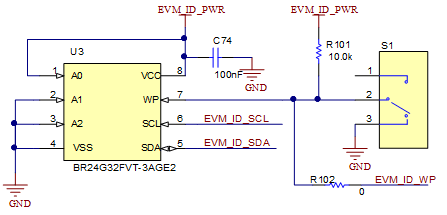SLAU298A November 2009 – May 2021
- Trademarks
- 1ADS8555EVM-PDK Overview
- 2EVM Analog Interface
- 3Digital Interface
- 4Power Supplies
- 5Installing the ADS8555EVM Software
-
6ADS8555EVM Operation
- 6.1 Connecting the Hardware and Running the GUI
- 6.2 Jumper Settings for the ADS8555EVM
- 6.3 Modifying Hardware and Using Software to Evaluate Other Devices in the Family
- 6.4 EVM GUI Global Settings for ADC Control and Registers
- 6.5 Time Domain Display
- 6.6 Frequency Domain Display
- 6.7 Histogram Display
- 7Bill of Materials, Layout, and Schematics
- 8Revision History
3.3 I2C Bus and EEPROM
The circuit shown in Figure 3-1 is used with the EVM controller (PHI) for EVM identification. This circuit is not required by the ADS8555 for operation. The switch (S1) is write protected and does not need to be changed for EVM operation.
 Figure 3-1 I2C Bus and
EEPROM
Figure 3-1 I2C Bus and
EEPROM